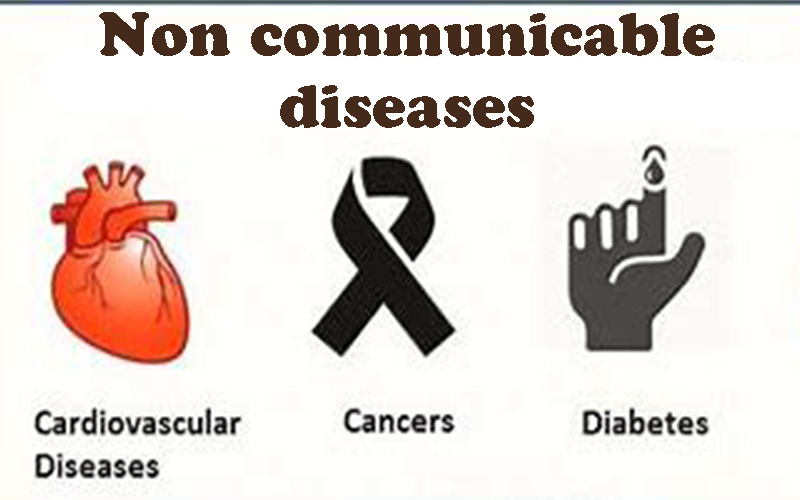Non-Communicable Diseases and their Prevention. The top four killers among NCDs with the highest number of deaths are cardiovascular diseases (17.9 million deaths annually), cancers (9.0 million), respiratory diseases (3.9 million), and diabetes (1.6 million).
Non-Communicable Diseases (NCDs), also known as chronic diseases, are medical conditions that are associated with long durations and slow progress. Most NCDs are non-infectious and are the result of several factors, including genetic, physiological, behavioural, and environmental factors. According to the World Health Organization (WHO), NCDs are the leading cause of death worldwide, responsible for 71% of the total number of deaths each year. The top four killers among NCDs with the highest number of deaths are cardiovascular diseases (17.9 million deaths annually), cancers (9.0 million), respiratory diseases (3.9 million), and diabetes (1.6 million).


However, the term of NCDs has been extended to cover a wide range of health problems, such as hepatic, renal, and gastroenterological diseases, endocrine, haematological, and neurological disorders, dermatological conditions, genetic disorders, trauma, mental disorders, and disabilities (e.g., blindness and deafness). The main risk factors contributing to NCDs involve unhealthy diets, physical inactivity, tobacco use, and alcohol misuse. Hence, most of these diseases are preventable as they eventually progress in early life due to lifestyle aspects.
Risk Factors of NCDs:
Several factors can increase the amount of opportunities to develop NCDs and can be classified as modifiable or non-modifiable factors that can have changeable or non-changeable conditions, respectively. The modifiable risk factors involve high blood pressure, smoking, diabetes mellitus, physical inactivity, obesity, and high blood cholesterol, while the non-modifiable risk factors involve age, gender, genetic factors, race, and ethnicity, interestingly, although age and gender are non-modifiable factors, most of their associated factors are modifiable.
The non-modifiable factors can also be classified into three classes:
- biological factors, such as being overweight, dyslipidaemia, hyper-insulinaemia, and hypertension;
- behavioural factors, such as diet, lack physical activity, tobacco smoking, and alcohol consumption; and
- Societal factors, which involve complex combinations of interacting socioeconomic, cultural and environmental parameters.
- Age Factors, While NCDs are usually associated with elderly people, all ages are at risk, even before birth sometimes these diseases may also start in the earliest years of life and keep progressing during childhood, adolescence, and old age.
- Diets and Lifestyle, in the past, infectious and parasitic diseases were the main causes of death, but in the recent decades, NCDs have replaced them and have become the main cause of deaths. This may be attributed to the change of diet habits and lifestyle over the years, which can be classified as a shift of disease patterns in humans.
The Economic Context, NCDs are already common in developed countries and rapidly propagate. Spreading western lifestyle in low and middle-income countries, due to global population aging and commercial pressures for unhealthy diets and cigarettes, contributes to the increasing rate of NCDs in these country. There is a direct relationship between poor health and low-income, which contributes to food poverty, purchasing of cheaper and unhealthy dietary products, and expensive treatments.
Key Diseases:
1. Cardiovascular Diseases (CVDs)
CVDs are the leading contributors to the global burden of disease among the NCDs and account for the most deaths worldwide each year—even more than the number of deaths from cancer and chronic respiratory diseases combined
2. Cancer
Cancer is the main public health problem and the second main cause of death globally [WHO]. It shares the common risk factors with other key diseases of NCDs and several identified and unidentified factors can be attributed to cancer. The causes of cancer can be classified into three categories, including:
- biological carcinogens (e.g., viral, bacterial, or parasites infections, hormonal and genetics factors);
- chemical carcinogens (such as food and water contamination, and tobacco smoking); and
- physical carcinogens (such as ultraviolet and ionizing radiation)
Chronic Respiratory Diseases (CRDs)
CRDs cover a wide range of diseases in the airways and the other structures of the lungs. Most of the morbidity and mortality of CRDs is increased with age. CRDs include chronic obstructive pulmonary disease (COPD), occupational lung diseases, asthma and respiratory allergies, sleep apnoea syndrome, and pulmonary hypertension. Asthma and COPD account for most of the deaths among CRDs in low and middle-income countries,
Diabetes Mellitus
Diabetes has attracted global attention due to its elevating prevalence and incidence. It is not only a chronic disease, but also an acutely life-threatening condition. Further, it may cause other serious diseases such as heart diseases, kidney failure, and eye damage, which may subsequently lead to blindness, and foot ulcers, which may require limb amputation etc.
Prevention and Management of NCDs:
Management of NCDs at Different Levels:
Global Level:
Design national policies and plans
Support and encourage research for NCDs prevention and control.
Monitor NCDs.
Support national and international partnerships for NCD prevention and control
Country Level:
Improve budgetary allocations to support primary health care systems
Engaging non-governmental organizations, research institutions, and private sector in collaborative partnerships for implementation of an action plan against NCDs.
Develop continuous quality improvement system focus on primary health care for prevention and management of NCDs.
Society Level:
Offer healthy food in the workplace.
Offer opportunities for physical activity in the workplace for all the ages.
Offer new resources from health-related non-governmental organizations to support the services for the prevention and control, treatment and care of NCDs.
Individual Levels:
Follow healthy lifestyle.
Hence In modern society, NCDs are the main challenge in health systems. Risk factor management is essential in NCDs’ management. The management of NCDs requires many strategies from several perspectives and on different levels, including the individual and country levels, and it can be concluded that modern strategies for the management of NCDs should be oriented toward the individual level, where the individual is responsible for their health by simply following a healthy lifestyle. It is important to combine modern scientific achievements and innovative decisions, with regard to the rationality of nutrition and positive effects on human health.
Dr. Vinayraj BG
Juggat Pharma












